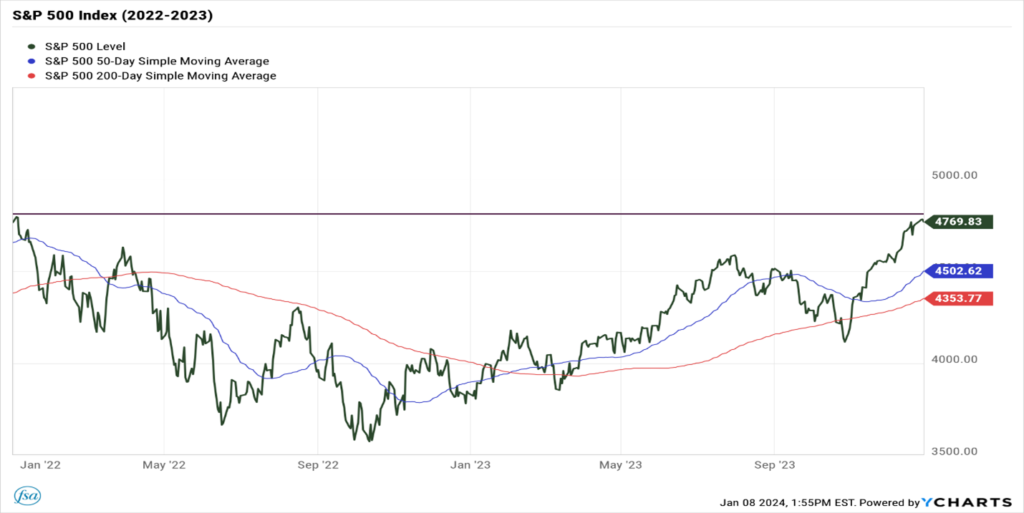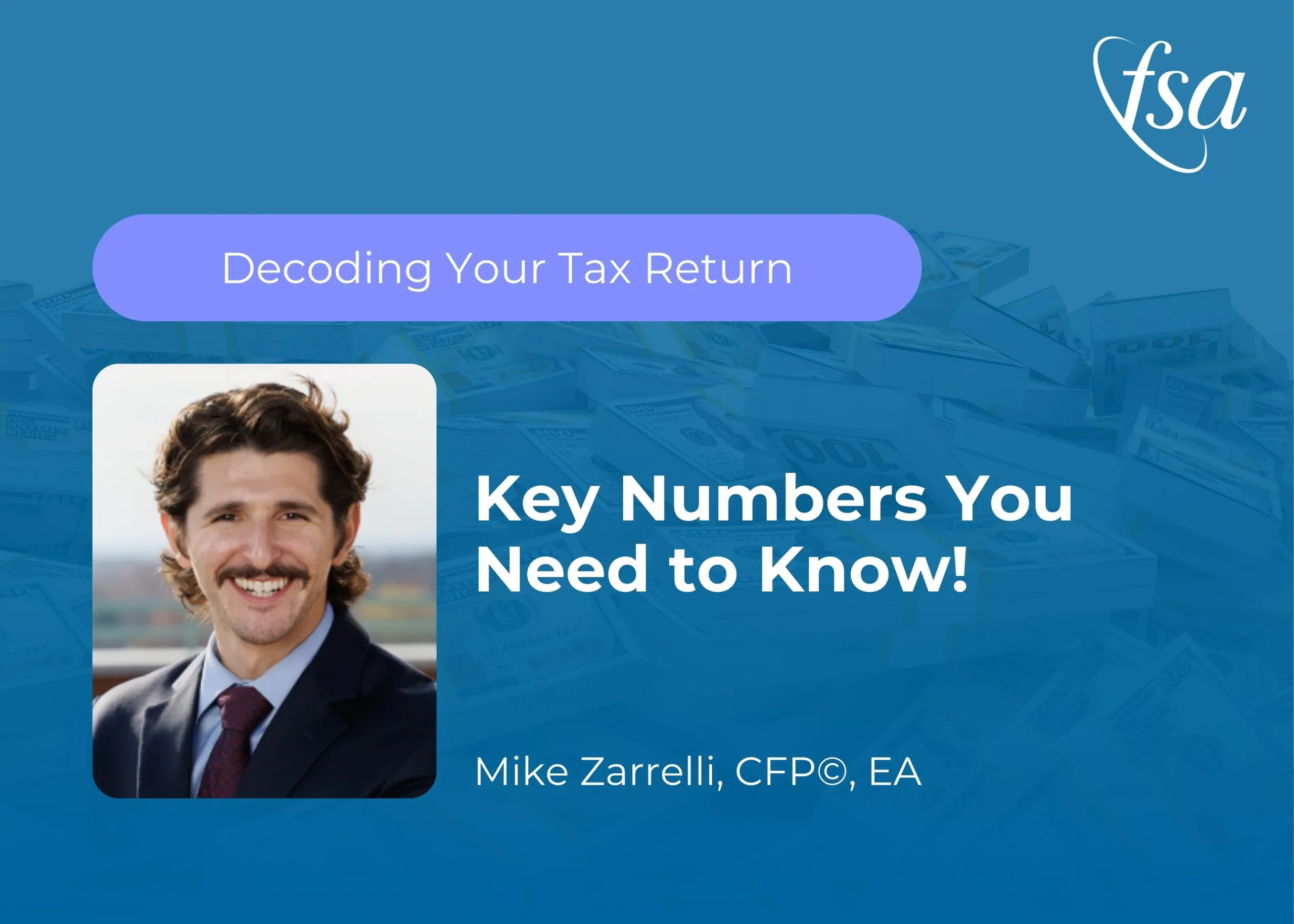After giving investors a scare from August through October, which saw stocks tumble over 10%, they mounted an impressive rally in the final two months, climbing over 10%. What distinguished this rally from the market action for most of the year, was that most every asset class and sector of the market participated. So, not only did the S&P 500 Index (with its heavy technology weighting) do well—rising 14%–but sectors other than technology also fared well. Small-cap stocks actually outpaced their larger cousins, rising over 20%. Even foreign stocks joined in the fun.
It was an amazing turn of events as at the end of October it appeared that stocks could be on the brink of a serious breakdown. Even though the ultra-big technology stocks were pulling the S&P 500 Index higher, the average stock was down for the year. Instead of falling into a more serious correction, stocks—and bonds—mounted a strong rebound and turned a potentially dismal year into a very respectable year. While nothing could keep pace with the S&P 500 Index, the year finished quite well for most broader areas of the market.
As the stock and bond markets began to rebound in November, we invested the remaining money market positions of the various FSA strategies (which had been increased in response to earlier market weakness). With stocks and bonds rallying broadly in November and December, the FSA strategies finished the year at their highs for the year. While we have not recouped all of the losses from 2021, we can see the light at the end of the tunnel. With any strength from the markets in 2024, we should see most strategies recoup their losses in 2024.
The table below shows the broad allocations of our seven active strategies:
 Outlook for 2024
Outlook for 2024
Election years have a reputation of being favorable for the stock market, as politicians like to do whatever they can to keep the voters happy so they can get re-elected. Interestingly, there have been some notable exceptions in recent times. In 2000 the internet bubble burst; in 2008 the financial crisis erupted; and of course, who could forget the pandemic that wreaked havoc in 2020.
The major debate among investors remains whether the economy will slip into recession this year (or early next year) or if we are able to manage a so-called soft landing in which the economy slows and inflation is reduced but we avoid a recession. The rally in stocks and bonds last year was a result of indications from the Federal Reserve Board that it might be finished with increasing interest rates and could possibly begin lowering them in 2024. Falling interest rates are good news for both stocks and bonds. Good news for stocks, that is, unless rates fall because the economy is slipping into recession. And that’s why the debate is so important. A soft landing implies the stock market can continue to climb, while a recession would lead to losses.
We look at markets through a technical lens, so the charts of various indices and securities give us clues on how to position our portfolios. From that perspective, it’s hard to be very negative right now. Over the short term (the past several months), most asset classes and sectors of the market have broken to the upside, as we discussed earlier. This is why we have all of the active strategies fully invested with very low money market levels (as seen in the table above). The only potential fly in the ointment is that stocks are having a hard time breaking out to new highs, which would confirm the resumption of the bull market.
The chart below shows the S&P 500 Index over the past two years (blue line is the 50-day moving average, the orange line is the 200-day moving average, and the purple line marks the all-time high for the S&P 500 Index). From this perspective we can see that the stocks represented in this index are having a hard time breaking above the highs set two years ago. The annualized return of the S&P 500 Index is literally 0%. If dividends are included dividends, the return bumps up to 1.7% each year, which was actually below the return that would have come from keeping your money in a money market fund.
So, the past two years have been difficult, to say the least. But do better days lie ahead? An interesting question, but I believe (and we’ll talk more about this in a future update) that the overall market environment will shift more in favor of our active investing style versus the buy-and-hold style the market has favored over the past ten years. If this shift occurs, it will imply more turbulence in the markets. So for 2024, there are reasons to be moderately optimistic, but beyond 2024, I believe it will be more critical than ever to be flexible and adaptable.

Portfolio Update
Keep in mind that because we manage clients’ portfolios individually, the holdings in your specific accounts may differ somewhat from the averages.
Strategies That Employ the FSA Safety Net®
Income (Strategy 1)
After languishing all year, high quality bonds finally caught fire in the last two months of the year, with the Barclays Aggregate Bond Index rising over 6% in the fourth quarter, generating a full year’s return in less than three months. The Income strategy was defensively positioned with floating rate funds and other short-term bond funds, so as bonds continued to rally, we reduced some of the defensive funds for more traditional bond funds, including some high yield bond funds. At year-end, this strategy held 20% in high yield bonds funds and 30% in traditional high quality bond funds, with 40% remaining in some of these defensive funds, leaving another 10% in money markets.
Income & Growth (Strategy 2)
As stocks and bonds rallied late in the year, we pushed this balanced strategy to its maximum invested levels, adding both stock funds and bond funds. We sold one of the floating rate funds in the portfolio, while adding a high yield fund, as well as several intermediate-term funds. Currently, the portfolios hold 50% in equities and 45% in bond funds, leaving only 5% in money markets.
Conservative Growth (Strategy 3)
With most stocks and bonds languishing for much of the year, we had very little to show through the end of October, but the final hurrah gave us an opportunity to generate some gains. We increased the equity allocation from 30% to 70% and bumped the bond allocation from 10% to 25%. That left us with a minimal money market allocation of 5%.
Core Equity (Strategy 4)
The rally in stocks brought the equity allocation in this strategy from 45% to 95%. With the exception of a modest 5% in a small-cap fund, the balance of the portfolio is invested in large U.S. companies. There are no sector funds in this strategy as of year-end. Allocations to money market funds is less than 5%.
Tactical Growth (Strategy 5)
During last year’s rally we brought the equity allocation from 55% to 95%, and all funds are large-cap U.S. funds. We sold the energy fund, but added a fund that invests in uranium mining and producing companies. We continue to hold a small allocation in a technology fund.
Active Strategies WITHOUT the FSA Safety Net®
Sector Rotation
After struggling all year without consistent momentum from the various sectors (besides technology), this strategy made the most of the final few months and finished the year with a double-digit return. As of the January rotation, the portfolio holds two financial services funds, plus a technology fund, industrials, retail stocks, and a real estate fund.
Global Rotation
This strategy struggled during the first two years of its existence but seemed to have found its footing last year, posting the best returns of all the FSA strategies. At year-end, this strategy remains heavily tilted towards technology-heavy growth stocks, which fared quite well in 2023.
Strategies That Remain Fully Invested Through ALL Market Cycles
Global Moderate
Diversification finally provided a boost to this passive portfolio, with real estate and small-caps stocks providing the most lift. Even the bond component contributed. Overall, it was a solid year for this balanced portfolio.
Global Growth
Diversification finally provided a boost to this passive portfolio, with real estate and small-caps stocks providing the most lift. Overall, it was a solid year for this equity portfolio.
Please remember to inform your advisor of any changes in your life that might affect your investment objectives and how we manage your money.
Ronald Rough, CFA
Chief Investment Officer
Disclosures are available at https://fsawealthpartners.com/disclosures/market-update/.
FSA’s current written Disclosure Brochure and Privacy Notice discussing our current advisory services and fees is also available at https://fsawealthpartners.com/disclosures/ or by calling 301-949-7300.




